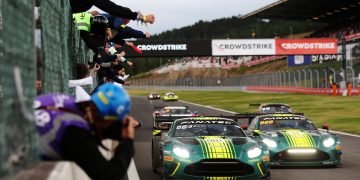
Ferrari has defended its decision not to pit Charles Leclerc and Carlos Sainz during the late-race Safety Car at the Formula 1 Miami Grand Prix.
The Scuderia saw its cars trail Max Verstappen to the flag in second and third, losing ground in both the drivers' and constructors' championships in the process.
Leclerc had started from pole and led the opening stanza of the race before tyre troubles saw him give up top spot to his Red Bull rival.
Ferrari pitted the championship leader on Lap 24, by which time Verstappen had built a sufficient lead that he was able to react and maintain the position when he pitted two laps later.
On the hard compound tyre, there was little between the two in terms of pace, though little Leclerc could do owing to the gap his rival had opened in the first stint.
That was until Lando Norris crashed out, triggering a Safety Car on Lap 41.
While Max Verstappen had already passed the pit entry as the call was made, Leclerc, third-placed Sainz, and Sergio Perez in fourth were all positioned such that they could react.
In Perez's case, Red Bull did, swapping him onto a set of new medium compound tyres.
It afforded him a grip advantage over Sainz in the closing laps as Ferrari chose to keep its two cars on track.
“I would have lost position to Checo [Perez],” explained Sainz as to why he didn't stop.
“You want to keep track position, especially [if] you're in the podium, I think you want to keep that position.
“Our alternative was I use soft or a new hard [tyre], which for me, both of them were not good enough for 10-12 laps to go.
“So we were better off staying out on a used hard, which I think was the right call because in the end we managed to keep him behind.”
It's a view shared by team boss Mattia Binotto.
“We believe that, in terms of format, our used tyres would have been stronger to a new one,” he said.
“So we decided simply to stay out because we believe that was the best chance for us to have a good warm up and try to attack in those first laps, which is what happened.”
Heading into the race, Red Bull held a distinct advantage when it came to available tyre sets.
Even after starting on the mediums, Verstappen had another brand new set of the yellow-walled tyres at his disposal, as well as three new sets of softs and one set of new hard rubber, with Perez in the same position.
At Ferrari, Leclerc and Sainz both started the race on their final brand new set of new mediums, meaning after their scheduled pre-race switch to hards they had only one unused set of the white-walled rubber and three sets of the softs available.
The medium compound tyre proved the preferred option in normal conditions, with the hard rubber taking time to warm up.
As such, should Ferrari have stopped either driver, the only realistic option was to fit a new set of hards and hope the tyre delta was sufficient to overcome Red Bull.
Had it done so, with Perez in fourth, the Mexican could simply have stayed on track and gained track position, leaving Ferrari with no guarantee that it could claw back the lost ground.
It was therefore an informed and calculated decision which played to the percentages and, as it transpired, proved the right call.










































